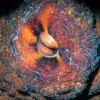From the world
Nitrogen – surface runoff and climate change
A team of Carnegie climatologists has published a study showing that rising temperatures due to climate change may have a greater impact on surface runoff of nitrogen into waters in the continental United States than the projected increase in precipitation. Until now, precipitation has been the dominant factor over temperature in determining the amount of nitrogen accumulating in American rivers.
Impact of climate change on nitrogen runoff into aquatic ecosystems
Climatologists from the Carnegie Institution for Science, forming a team led by Anna Michalak and Gang Zhao, have been studying for the past decade the effects of climate change on nitrogen runoff into aquatic ecosystems and what threats to water quality may result. The researchers analyzed data from several decades that monitored the movement of the chemical element in continental river systems in the United States. They used them to predict the future trajectories of its movement in climate change scenarios.
The researchers noted that rising temperatures are likely to offset or even reduce excess nitrogen flushed into rivers in the U.S., despite a projected increase in rainfall. Their findings are the opposite of those of recent decades, when increases in precipitation outpaced global warming, leading to greater pollution of waters with compounds of this biogenic element. Michalak, Zhao and the rest of the team believe their work provides a critical foundation for future research into the interplay between the path taken by nitrogen and climate change in the context of rising temperatures.
“Although the impact of climate change-induced changes in rainfall patterns has been investigated, to date the effect of rising temperatures on the movement of nitrogen into aquatic environments has not been quantified at the continental scale due to a lack of available data,” explains study co-author Gang Zhao.
Relative roles of temperature and rainfall changes
Average, as well as extreme, rainfall influences the amount of nitrogen runoff from land into waterways, and how long it takes for it to reach the aquatic environment where it will eventually create hazardous conditions. Indirectly, temperature also affects the amount of this biogenic element entering waterways, as warming increases evaporation, which in turn prevents it from entering rivers.
“Our research illustrates the complex and sometimes surprising ways in which climate change affects our planet’s dynamic system,” Michalak said. “Unraveling the multiple factors that are changing the impact of climate change on water quality will help farmers, land managers and policymakers pursue the best possible strategies to ensure water quality protection while ensuring sustainable food production and water supply.”
It turns out that understanding the relative roles of temperature change and rainfall is critical to designing water quality management strategies that must be resilient to climate change, while also aiming to provide communities with a sustainable supply of food and water.
Nitrogen and phosphorus cause eutrophication
Human activity has changed the way this biogenic element moves through the planet’s terrestrial, aquatic and atmospheric systems. Nitrogen from fertilizers enters the waters and leads to eutrophication (nutrients increase water fertility), resulting in algal blooms. They secrete dangerous toxins, which in turn lead to low-oxygen dead zones (called hypoxia). Water eutrophication is a progressive process of degradation of the aquatic ecosystem. Over the past few years, there has been a buzz throughout the United States about large numbers of algal blooms in lake and coastal regions.
Eutrophication threatens water resources worldwide. In Poland, bathing beaches are being closed due to algal blooms, and the Baltic Sea has the world’s largest marine dead zone. Given the current dimension of the impact of farming on the environment, it is becoming urgent to take action and implement various solutions – in the article “What kind of agricultural policy do Polish rivers and the Baltic Sea need?” mentioned are reports by OTOP (the National Society for the Protection of Birds), which has attempted to gather knowledge on nature-based solutions aimed at reducing area nutrient runoff into aquatic ecosystems.

 Polski
Polski







